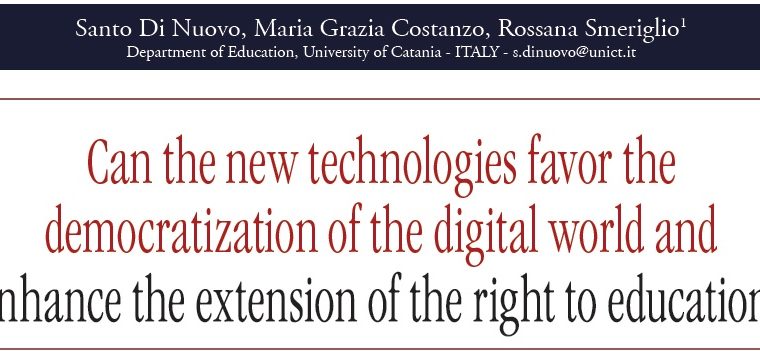Santo Di Nuovo, Maria Grazia Costanzo, Rossana Smeriglio
Department of Education, University of Catania – ITALY – s.dinuovo@unict.it
Summary
The paper presents the possibilities of extending and democratizing the digital world and the Artificial Intelligence that underlies it. Are the advances of new technologies in education, including robotics, effective and efficient in improving educational processes? Can they contribute to extending the rights to education to all social groups of the population and to all countries of the world, or, on the contrary, do they risk becoming a further opportunity for discrimination for the groups that cannot make adequate use of them?
1. The advantages of new technologies
in education
New and effective training practices are facilitated by the widespread diffusion of Educational Technology (Januszewski & al., 2008). The current world generation of „digital natives“ can develop new forms of educational relationships with technology, thanks to mobile devices (smartphones, game consoles, and tablets), and the application of virtual reality, up to robotics.
Education – beyond distance teaching opportunities, which we will not deal with in this paper – can benefit from technologies that offer a wide availability of linguistic, auditory, visual stimuli, and also stimulate motor skills; allowing customization and constant monitoring of progress. Pupils are engaged at their own pace and needs and can take control of their own learning processes (Selwyn, 2011; Schindler & al., 2017).
More and more attention is paid to the great potential of technologies also for the inclusion and facilitation of learning for students with disabilities or other neurodevelopmental deficits.
Technologies favor the enhancement of cognitive functions, such as attention, automation of skills necessary for reading, understanding meaning, finalized and sequential thinking for problem-solving. Automation favors multitasking, which otherwise could lead to the weakening of the various processes involved simultaneously.
Other cognitive functions can be enhanced by correct use of technologies, for example, mental imagery useful for creative learning, and visuospatial orientation necessary for the rehabilitation of neurodevelopmental deficits.
Emotional and relational skills can also be stimulated and developed by exploiting the technological tools children and adolescents are used to. Educational games (defined as edugames) based on new technologies favor the education of social as well as cognitive skills. They are also called serious games, because they entertain and educate at the same time, applying models based on psychological and educational theories. For example, in role-playing games, virtual environments allow educational and training experiences to develop so-called soft skills – such as communication, relational competence, self-confidence, and anxiety management, – and improve mental and behavioral models with which the student faces problems and actively adapts to the demands of the environment.
2. Assistive Robotics in education
In particular, Socially Assistive Robotics is spreading more and more in the school field, which uses social interaction with small humanoid robots, simplified compared to real persons, but who speak in a simple but clear way, move with slow gestures and predictable behaviors, such as to stimulate the socialization of children even with behavioral problems. Robots appear as game companions, but they can be programmed to help teaching and learning processes, without however becoming an alternative to human relationships. Their function is to mediate with the educators, supporting them (without ever replacing them) in learning and then extending what has been learned by playing with the robot to relationships with the living environment.
The educator, using a plan programmed with his direct participation, remotely controls the interaction and guides him towards the foreseen learning objectives, monitoring their achievement.
The potential of social robotics is also to allow and encourage mobility and interaction in children, avoiding the risks of computers such as a sedentary lifestyle and a tendency to isolate.
Children initially perceive the robot as a toy, albeit intelligent and capable of good verbal and non-verbal communication. Then they learn to consider him as a member of their class group, showing empathy towards him, and helping him when he is in trouble, e.g., if he falls down.
Robots can display different characteristics of people’s social behavior, this may contribute to creating „a simplified, safe, predictable and reliable environment where the complexity of interaction can be controlled and gradually increased“ (Robins & al. 2005, p. 108).
Recent research in the area of robotics has made available numerous possibilities for further innovation in the education of children (Jacq et al., 2016), including those with learning difficulties and/or intellectual disabilities (Conti & al., 2016). Educational robots are expected to facilitate children’s learning and they may improve their literacy and creativity. Previous research in human-robot interaction explored the use of robots as storytellers (Chen and Wang 2011); the influence of different social behaviors on preschool children’s perception of stories narrated either by a humanoid robot or by a human teacher has been studied (Conti & al., 2017).
The success of this approach can be favored by the preference of interacting with a humanoid social robot rather than a non-embodied computer screen, as found in young children and older adults (Feingold Polak & al., 2018). When the robot held the child’s attention and interest in both itself and the tasks, it is possible to extend the educational sessions for a longer time period (Baxter, & al. 2017).
Even with small children, the robot in the classroom can motivate students and promote the acquisition of skills in ’natural‘ ways. For example, the vocabulary of children of a few years (or older but with a language deficit) can be developed, enriching the narratives with emotions transmitted through the robot’s gestures and postures. Similarly, the robot can help improve reading skills better than other technologies, especially in dyslexic children; and it can also facilitate the learning of foreign languages, also in immigrant pupils: The robot can easily speak different languages and act as a participatory translator during a dialogue. A small robot like BeeBot facilitates the learning of mathematics in elementary school by creating an innovative, creative, and fun learning environment that is passionate and engaging for both teachers and students (Beltrametti & al. 2017).
Robots can improve motivation and problem-solving skills, for example with cognitive exercises for learning the preconditions of actions, planning, and resolution systems (Suárez-Hernández & al., 2021).
Robots evoke emotional reactions potentially leading to specific emotional bonds between humans and machines (Eyssel, 2017). Gamborino et al. (2018) implemented the Interactive Reinforcement Learning paradigm using the robot to socially involve primary school children and improve their mood, demonstrating that the robot can learn how to intervene optimally according to the child’s characteristics.
Robotics combined with augmented reality and virtual worlds can activate and enhance people’s cognitive resources, trigger or support virtuous circles from which learning and social interaction can benefit, give positive results to processes of inclusion of pupils with special needs or at risk of marginalization (Menichetti, 2019)
Robots create opportunities to learn through interaction, and this enhances their usefulness in educational and rehabilitation settings.
3. Applications of Social Robotics for
disability and special educational needs
Even students with disabilities – and in particular with Autism – can learn new skills and develop both cognitive skills and relational and collaborative skills using the robot as a mediator between the child and the human operator (e.g., Conti & al. 2021; Santos & al., 2021). Conversely, the other pupils can be sensitized positively towards their disabled classmates, learning to understand their psychic or physical needs while playing with them together with the robot.
Specific studies have validated robotic applications for pupils with special educational needs. To improve the cognitive, behavioral, and social skills of these children, D’Amico et al. (2019) proposed the RE4BES protocol, aimed at the realization of personalized robotic activities concerning the stimulation of visuospatial skills and those of focused attention, whose efficacy has been tested.
Another study tested the effectiveness of school Educational Robotics Labs (ER-Labs) in promoting the executive functions of individuals with special educational needs through fun, intense, and progressively more challenging activities that require programming the bee-shaped robot called Bee-bot (Di Lieto et al., 2020). All the children showed a high level of interest and motivation during the ER-Lab activities. According to the teachers‘ qualitative observations, this setting was important for promoting more effective learning but also social inclusion.
Robotics has also shown to be useful for the treatment of hyperactive disorders if applied according to scientifically validated criteria (for a complete and updated review: Berrezueta- Guzman et al., 2022). Despite favorable overall results on specific applications, robotic technologies that support ADHD therapies, to be applied effectively, require significant improvements in terms of human-machine interaction, and treatment and processing of acquired information.
4. Acceptability studies of educational
technologies
All technologies (from educational software to virtual games to robotics) can be useful in schools if the attitude of teachers and educators overcome the prejudicial concerns that they ‚depersonalize‘ the educational process and are artificial substitutes for traditional education. They are ‚intelligent‘ and intelligently programmable collaborators, not substitutes, to be used when human support is not available or effective. But we should also avoid, on the contrary, an uncritical acceptance that delegates to technology the solution to school problems that cannot otherwise be tackled.
Specific studies have investigated teachers‘ and educators‘ perceptions of robotics, using the Unified Theory of Acceptance and Use of Technology (UTAUT) model, which examines the factors that influence the decision to use a robot in educational practice. The results of extensive research on clinicians, both expert and in training (Conti et al., 2017), have shown that despite an overall positive attitude towards the use of the robot, a certain skepticism persists among clinicians, who perceive the robot as an expensive and limited tool, while psypsychologists and educators show more positive perception and significantly higher willingness to use the robot. It has been hypothesized that robots may be better accepted for rehabilitation if they are more closely integrated with standard rehabilitation protocols, so that the overall benefits may outweigh the costs.
A model merging already described UTAUT and the Post Acceptance Model was used by Han & Conti (2020) to evaluate the acceptability after the actual use of a telepresence robot. The experimental results show a positive attitude towards the use of the robot in telepresence in a school context and confirm the applicability of the model in an educational context.
Negrini (2020) analyzed the attitudes toward educational robotics of 174 teachers differentiated by gender, age, region, school order and disciplines taught. The results show that, in general, teachers are interested in educational robotics and perceive it as useful for the development of transversal learning skills. Some factors limiting the implementation of robotics at school are the costs, the time needed to prepare the activities, and the fact that technologies are massively present in our daily lives, and therefore some teachers hesitate to implement them even at school.
5. Toward the right to education
through new technologies
Postman wrote in 1992 that we need to know in what ways technologies are modifying our conception of learning and teaching. Now we have to understand how technologies can contribute to the right to education through a democratic diffusion of the digital world.
To this end, a theoretical foundation of didactics and psychology of cognitive and social learning is necessary, which allows technologies to be organically inserted into the educational programming for which the school “of all and for all” is responsible. Furthermore, technologies should be used flexibly in individualized programming to respond to the specific educational needs of pupils.
But educational technology, including robotics, risks becoming a further object of the “digital divide”, understood as a gap between those (families, schools, educational systems) who have easy access to digital technologies and those who are excluded, for variables as social status, income, geographical location (Jenkins, 2009; Wei & Hindman, 2011; Ragnedda & Muschert, 2013).
An essential aspect of the positive diffusion of new technologies in the educational field is their economic sustainability (i.e., making it accessible to as many people and educational contexts as possible), and this is possible thanks to the strong reduction in the costs of virtual reality and robotics, and its diffusion not as an option for those who are richer in resources but as a tool for all targets of the educational process, within national systems and between international systems (Klang & Murray, 2005).
Easy usability and generalized acceptability by potential users must be added to economic sustainability, which should be explored experimentally in different contexts and for specific users.
And, last but not least, the ethical and legal problems concerning the security and protection of computer data must be considered.
These conditions can favor the generalized use of new technologies in the educational field: the democratization of the Digital World is one of the conditions for the extension of the rights to education, which must be validated on a scientific level, but also considered as a social problem and pursued by global welfare politics.
References
Amato F., Di Gregorio M. Monaco C., Sebillo M.,
Tortora G., Vitiello G. (2021) Socially Assistive Robotics
combined with Artificial Intelligence for ADHD. IEEE 18th
Annual Consumer Communications & Networking Conference(
CCNC). DOI: 10.1109/CCNC49032.2021.9369633
Baxter, P., Ashurst, E., Read, R., Kennedy, J., & Belpaeme,
T. (2017). Robot education peers in a situated primary
school study: Personalisation promotes child learning.
PloS One, 12 (5): e0178126. https://doi.org/10.1371/
journal.pone.0178126.
Beltrametti, M., Campolucci, L., Maori, D., Negrini, L., &
Sbaragli, S. (2017). La robotica educativa per l’apprendimento
della matematica. Un’esperienza nella scuola
elementare. Didattica della Matematica, 1, 123-144.
https://doi. org/10.33683/ddm.17.1.7
Berrezueta-Guzman J., Robles-Bykbaev E.V., Pau I.,
PesántezAvilés F., Martín-Ruiz M.L. (2022) Robotic
Technologies in ADHD Care: Literature Review,
IEEE Access, 10, pp. 608-625. doi: 10.1109/ACCESS.
2021.3137082
Chen G.-D. and Wang C.-Y. (2011), A survey on
storytelling with robots, in International Conference on
Technologies for ELearning and Digital Entertainment,
pp. 450–456. https://doi.org/10.1007/978-3-642-
23456-9_81
Conti D., Di Nuovo S., Buono S., and Di Nuovo A.
(2016), Robots in education and care of children with
developmental disabilities: a study on acceptance by experienced
and future professionals, International Journal
of Social Robotics, pp. 1–12. https://doi.org/10.1007/
s12369-016-0359-6
Conti D., Di Nuovo A., Cirasa C., Di Nuovo S. (2017) A
comparison of kindergarten storytelling by human
and humanoid robot with different social behavior.
ACM/IEEE International Conference on Human-Robot
Interaction (HRI2017) Wien, pp. 97–98 DOI:
10.1145/3029798.3038359
Conti, D., Trubia, G., Buono, S., Di Nuovo, S., Di Nuovo,
A. (2021). An empirical study on integrating a small
humanoid robot to support the therapy of children with
Autism Spectrum Disorder and Intellectual Disability.
Interaction Studies,22(2), 177-211. https://doi.
org/10.1075/is.21011.con
D’Amico, A., & Guastella, D. (2019). The Robotic
Construction Kit as a Tool for Cognitive Stimulation in
Children and Adolescents: The RE4BES Protocol.Robotics,
8(1), 8. https:// doi.org/10.3390/robotics8010008
Di Lieto, M. C., Castro, E., Pecini, C., Inguaggiato, E.,
Cecchi, F., Dario, P., Cioni, G., & Sgandurra, G. (2020).
Improving Executive Functions at School in Children
With Special Needs by Educational Robotics.Frontiers
in psychology,10, 2813. https://doi.org/10.3389/
fpsyg.2019.02813
Eyssel, F. (2017). An experimental psychological
perspective on social robotics. Robotics and Autonomous
Systems, 87, 363-371. https://doi.org/10.1016/j.
robot.2016.08.029
Feingold Polak, R., Elishay, A., Shahar, Y., Stein, M., Edan,
Y., & Levy-Tzedek, S. (2018). Differences between Young
and Old Users when Interacting with a Humanoid Robot:
A Qualitative Usability Study. ACM/IEEE International
Conference on Human-Robot Interaction (pp. 107-108).
https://doi.org/10.1145/3173386.3177046
Gamborino, E., & Fu, L. (2018). Interactive Reinforcement
Learning based Assistive Robot for the Emotional
Support of Children. In 2018 18th International Conference
on Control, Automation and Systems (ICCAS),
708-713.
Han J, Conti D. (2020) The Use of UTAUT and Post
Acceptance Models to Investigate the Attitude towards a
Telepresence Robot in an Educational Setting. Robotics,
9(2):34. ; https://doi.org/10.3390/robotics9020034
Jacq A., Garcia F., Dillenbourg P., Paiva A. (2016). Building
successful long child-robot interactions in a learning
context, in 2016 11th ACM/IEEE International Conference
on Human- Robot Interaction (HRI), pp. 239–246.
Januszewski, A., Molenda, M. & Association for
Educational Communications and Technology (2008).
Educational technology: a definition with commentary,
Lawrence Erlbaum Associates.
Jenkins, H. (2009) Confronting the Challenges of Participatory
Culture: Media Education for the 21st Century.
Cambridge: MIT Press.
Klang, M. & Murray, A. (2005). Human rights in the
digital age. London: Routledge
Menichetti, L. (2019). Robotics, augmented reality,
virtual worlds, to support cognitive development, learning
outcomes, social interaction, and inclusion.Form@
re,19(1), 1-11. https://doi.org/10.13128/formare-24496
Negrini, L. (2020). Teachers’ attitudes towards
educational robotics in compulsory school. Italian
Journal of Educational Technology, 28(1), 77-90. doi:
10.17471/2499-4324/1136
Postman, N. (1992).Technopoly: the surrender of culture
to technology. New York, NY: Vintage Books.
Ragnedda, M. & Muschert, G.W. (eds) (2013). The digital
divide: the internet and social inequality in international
perspective. London: Routledge.
Robins, B., Dautenhahn, K., Boekhorst, R. Te, & Billard,
A. (2005). Robotic assistants in therapy and education
of children with autism: can a small humanoid robot
help encourage social interaction skills? Universal Access
in the Information Society, 4 (2), 105-120. https://doi.
org/10.1007/s10209-005-0116-3
Santos, L., Geminiani, A., Schydlo, P., Olivieri, I., Santos-
Victor, J., & Pedrocchi, A. (2021). Design of a robotic
coach for motor, social and cognitive skills training toward
applications with ASD children. IEEE Transactions
on Neural Systems and Rehabilitation Engineering,29,
1223-1232. doi: 10.1109/TNSRE.2021.3091320
Schindler, L.A., Burkholder, G.J., Morad, O. A., Marsh,
C. (2017).Computer-based technology and student
engagement: a critical review of the literature. International
Journal of Educational Technology in Higher
Education.14(1): 25.doi:10.1186/s41239-017-0063-0.
Selwyn, N. (2011),Education and Technology: Key Issues
and Debates, London: Continuum International.
Suárez-Hernández A., Andriella A., Taranović A., Segovia-
Aguas J.,Torras C., & Alenyà G. (2021) Automatic
Learning of Cognitive Exercises for Socially Assistive
Robotics“, 30th International Conference IEEE Robot e
Human Interactive Communication (RO-MAN) pp. 139-
146, doi: 10.1109/ROMAN50785.2021.9515433.
Wei, L. & Hindman, D. (2011). Does the digital divide
matter more? Comparing the effects of new media and
old media use on the education-based knowledge gap.
Mass Communication and Society14: 216–235. https://
doi.org/10.1080/15205431003642707











